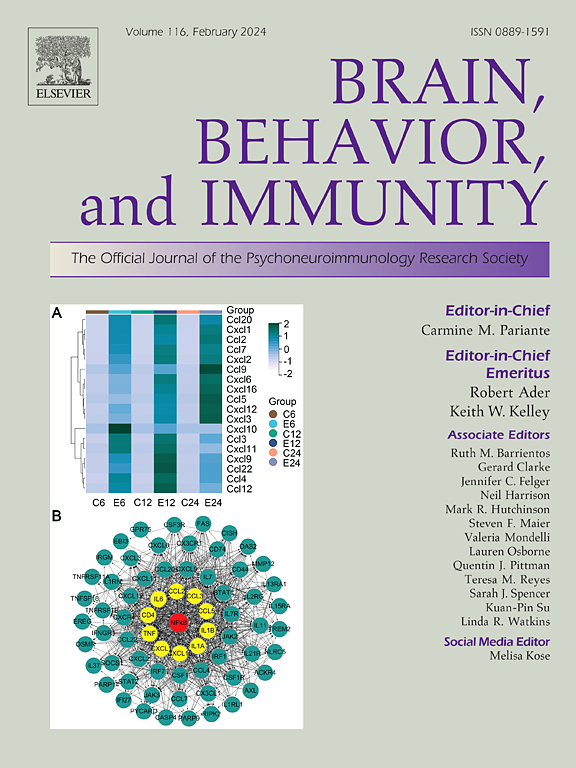The greater splanchnic nerve preferentially regulates neutrophils over macrophages in a rat model of septic peritonitis
IF 7.6
2区 医学
Q1 IMMUNOLOGY
引用次数: 0
Abstract
The sympathetic splanchnic nerve is a major player in immunoregulation, but its specific roles during infection have yet to be elucidated. Here, we evaluated how bilateral ablation of the greater splanchnic nerve (SplancX) impacts bacterial burden and immune function in a rat model of E. coli-induced septic peritonitis. SplancX had a major effect on bacterial burden within 24 h, reducing it to 4 % in the peritoneum and to 8 % in the spleen of what was found in the sham-operated controls. Such a major effect was not explained by gross changes in the infiltration of these sites with innate immune cells (neutrophils and macrophages), as assessed by flow cytometry. Single-cell RNA sequencing was then employed to evaluate the cellular activation programs of leukocyte subsets. Of the nine cellular clusters identified in the peritoneum of the infected rats, three of them had a transcriptional signature of activated neutrophils and two of them corresponded to quiescent neutrophils with an immunosuppressive signature. SplancX shifted the balance between these neutrophil subsets in a way consistent with heightened immunity, i.e., the activated neutrophils were augmented whereas the quiescent neutrophils were reduced in the SplancX group. The remainder of the clusters consisted of macrophages and erythrocytes, none of which changed in a way that could account for the observed effects on bacterial clearance. Confirming that SplancX resulted in heightened neutrophil activation, protein markers of neutrophil degranulation and NETosis were found to be elevated in the peritoneal lavage of the SplancX group. Taken together, the data show that the splanchnic nerve exerts a major effect on bacterial clearance in the acute phase of infection, presumably owing to selective changes in the balance between microbicidal and quiescent subsets of neutrophils.
在脓毒性腹膜炎大鼠模型中,内脏大神经优先调节中性粒细胞而不是巨噬细胞
内脏交感神经是免疫调节的主要参与者,但其在感染中的具体作用尚未阐明。在这里,我们评估了双侧切除内脏大神经(SplancX)如何影响大肠杆菌诱导的脓毒性腹膜炎大鼠模型中的细菌负荷和免疫功能。SplancX在24小时内对细菌负荷有主要影响,将腹膜中的细菌负荷降低到4%,脾脏中的细菌负荷降低到8%,与假手术对照组相比。这种主要作用不能用流式细胞术评估的先天免疫细胞(中性粒细胞和巨噬细胞)浸润这些部位的明显变化来解释。然后使用单细胞RNA测序来评估白细胞亚群的细胞激活程序。在感染大鼠腹膜中发现的9个细胞簇中,其中3个具有活化中性粒细胞的转录特征,其中2个对应于具有免疫抑制特征的静止中性粒细胞。SplancX以一种与增强免疫力相一致的方式改变了这些中性粒细胞亚群之间的平衡,即,在SplancX组中,活化的中性粒细胞增加,而静止的中性粒细胞减少。其余的细胞簇由巨噬细胞和红细胞组成,它们的变化都不能解释观察到的对细菌清除的影响。证实SplancX导致中性粒细胞活化升高,中性粒细胞脱粒和NETosis蛋白标记物在SplancX组腹腔灌洗中升高。综上所述,这些数据表明,在感染的急性期,内脏神经对细菌清除发挥了重要作用,可能是由于嗜中性粒细胞的杀微生物亚群和静止亚群之间平衡的选择性变化。
本文章由计算机程序翻译,如有差异,请以英文原文为准。
求助全文
约1分钟内获得全文
求助全文
来源期刊
CiteScore
29.60
自引率
2.00%
发文量
290
审稿时长
28 days
期刊介绍:
Established in 1987, Brain, Behavior, and Immunity proudly serves as the official journal of the Psychoneuroimmunology Research Society (PNIRS). This pioneering journal is dedicated to publishing peer-reviewed basic, experimental, and clinical studies that explore the intricate interactions among behavioral, neural, endocrine, and immune systems in both humans and animals.
As an international and interdisciplinary platform, Brain, Behavior, and Immunity focuses on original research spanning neuroscience, immunology, integrative physiology, behavioral biology, psychiatry, psychology, and clinical medicine. The journal is inclusive of research conducted at various levels, including molecular, cellular, social, and whole organism perspectives. With a commitment to efficiency, the journal facilitates online submission and review, ensuring timely publication of experimental results. Manuscripts typically undergo peer review and are returned to authors within 30 days of submission. It's worth noting that Brain, Behavior, and Immunity, published eight times a year, does not impose submission fees or page charges, fostering an open and accessible platform for scientific discourse.

 求助内容:
求助内容: 应助结果提醒方式:
应助结果提醒方式:


